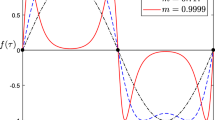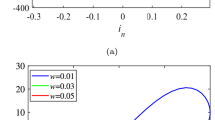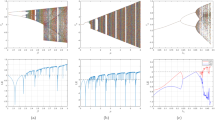Abstract
In this work, an indirect coupling used in a pair of simple autonomous discrete systems in order to enhance the emergence of hyperchaos is presented. The peculiarity that the used systems will never generate chaotic or hyperchaotic dynamics by itself makes this case an interesting problem to address. Moreover, it is possible to achieve in-phase or anti-phase synchronization by varying some parameters of the indirect coupling. Additionally, different methods to analyze the emerging dynamics of the coupled systems using an indirect coupling compared to a conventional coupling are presented. Finally, an electronic digital implementation is conducted by using the SPI protocol of two coupled PIC-24FJ64GA006 16-bit microcontrollers.













Similar content being viewed by others
Data availability
All data generated or analyzed during this study are included in this published article.
References
Hai-Feng, Z., Rui-Xin, W., Xin-Chu, F.: The emergence of chaos in complex dynamical networks. Chaos Soliton Fract. 28(2), 472–479 (2006)
Fiordilino, E.: The emergence of chaos in quantum mechanics. Symmetry 12(5), 785 (2020)
Plan, E.L.C.V.M., Musacchio, S., Vincenzi D.: Emergence of chaos in a viscous solution of rods. Phy. Rev. E 96, 053108 (2017)
Andreev, A.V., Balanov, A.G., Fromhold, T.M., Greenaway, M.T., Hramov, A.E., Li, W., Makarov, V.V., Zagoskin, A.M.: Emergence and control of complex behaviors in driven systems of interacting qubits with dissipation. npj Quantum Inf. 7(1) (2021)
Ghosh, A., Sujith, R.I.: Emergence of order from chaos: a phenomenological model of coupled oscillators. Chaos Soliton Fract. 141, 110334 (2020)
Chun-Ni, W., Ma, J., Liu, Y., Huang, L.: Chaos control, spiral wave formation, and the emergence of spatiotemporal chaos in networked Chua circuits. Nonlinear Dyn. 67(1), 139–146 (2012)
Van Gorder, R.A.: Emergence of chaotic regimes in the generalized Lorenz canonical form: a competitive modes analysis. Nonlinear Dyn. 66, 153–160 (2011)
Manjunath, S., Podapati, A., Raina, G.: Stability, convergence, limit cycles and chaos in some models of population dynamics. Nonlinear Dyn. 87(4), 2577–2595 (2017)
Ulrichs, H., Mann, A., Parlitz, U.: Synchronization and chaotic dynamics of coupled mechanical metronomes. Chaos 19(4), 043120 (2009)
Arellano-Delgado, A., López-Gutiérrez, R.M., Murillo-Escobar, M.A., Cardoza-Avendaño, L., Cruz-Hernández, C.: The Emergence of Hyperchaos and Synchronization in Networks with Discrete Periodic Oscillators. Entropy 19(8), 1–15 (2017)
Blasius, B., Huppert, A., Stone, L.: Complex Dynamics and Phase Synchronization in Spatially Extended Ecological Systems. Nature 399, 354–359 (1999)
Strogatz, S.H.: Spontaneous synchronization in nature. In: Proceedings of International Frequency Control Symposium, pp. 2–4 (1997)
Hyun-Ho, C., Jung-Ryun, L.: Principles, applications, and challenges of synchronization in nature for future mobile communication systems. Mob. Inf. Syst. 2017, 8932631 (2017)
Hale, J.K.: Diffusive coupling, dissipation, and synchronization. J. Dyn. Differ. Equ. 9, 1–52 (1997)
Brauns, F., Halatek, J., Frey, E.: Diffusive coupling of two well-mixed compartments elucidates elementary principles of protein-based pattern formation. Phys. Rev. Res. 3, 013258 (2021)
Van Quoc, T., Minh Hoang, T., Nam Hoai, N., Hyo-Sung, A.: Free-will arbitrary time consensus protocols with diffusive coupling. Int. J. Robust Nonlin. 32(15), 8711–8731 (2022)
Pena Ramirez, J., Arellano-Delgado, A., Nijmeijer, H.: Enhancing master-slave synchronization: The effect of using a dynamic coupling. Phys. Rev. E. 98(1), 012208 (2018)
Arellano-Delgado, A., López-Gutiérrez, R.M., Méndez-Ramírez, R., Cardoza-Avendaño, L., Cruz-Hernández, C.: Dynamic coupling in small-world outer synchronization of chaotic networks. Phys. D 423, 132928 (2021)
Pena Ramirez, J., Garcia, E., Alvarez, J.: Master-slave synchronization via dynamic control. Commun. Nonlinear Sci. 80, 104977 (2020)
de Jonge, W., Pena Ramirez, j., Nijmeijer, H.: Dynamic coupling enhances network synchronization. IFAC Papers OnLine. 52(16), 610–615 (2019)
Buscarino, A., Fortuna, L., Patanè, L.: Master-slave synchronization of hyperchaotic systems through a linear dynamic coupling. Phys. Rev. E 100, 032215 (2019)
Rubio-Pecasso, J., López-Gutiérrez, R.M., Arellano-Delgado, A., Cruz-Hernández, C.: Quadcopter formation using backstepping control and dynamic coupling in master–slave configuration. In: 2022 International Conference on Control, Robotics and Informatics, pp. 2–4 (2022)
Méndez-Ramírez, R.D., Arellano-Delgado, A., Murillo-Escobar, M.A., Cruz-Hernández, C.: A New 4D Hyperchaotic System and Its Analog and Digital Implementation. Electronics 10(15), 1793 (2021)
Méndez-Ramírez, R.D., Arellano-Delgado, A., Murillo-Escobar, M.A., Cruz-Hernandez, C.: A new 4D hyperchaotic system and its analog and digital implementation. Electronics 10(15), 1793 (2021)
Tlelo-Cuautle, E., Carbajal-Gomez, V.H., Obeso-Rodelo, P.J. Rangel-Magdaleno., J. J. Núñez-Pérez J. C.: FPGA realization of a chaotic communication system applied to image processing. Nonlinear Dyn. 82, 1879–1892 (2015)
Bonny, T., Nasir, Q.: Clock glitch fault injection attack on an FPGA-based non-autonomous chaotic oscillator. Nonlinear Dyn. 96, 2087–2101 (2019)
Rodríguez-Orozco, E., García-Guerrero, E.E., Inzunza-Gonzalez, E., López-Bonilla, O.R., Flores-Vergara, A., Cárdenas-Valdez, J.R., Tlelo-Cuautle, E.: FPGA-based chaotic cryptosystem by using voice recognition as access key. Electronics 7, 414 (2018)
Benkouider, K., Vaidyanathan, S., Sambas, A., Tlelo-Cuautle, E., El-Latif, A.A.A., Abd-El-Atty, B., Bermudez-Marquez, C.F., Sulaiman, I.M., Awwal, A.M., Kumam, P.: A New 5-D multistable hyperchaotic system with three positive lyapunov exponents: bifurcation analysis, circuit design, FPGA realization and image encryption. IEEE Access. 10(22014271), 90111–90132 (2022)
Leng, X., Du, B., Gu, S., He, S.: Novel dynamical behaviors in fractional-order conservative hyperchaotic system and DSP implementation. Nonlinear Dyn. 109, 1167–1186 (2022)
Liu, T., Yan, H., Banerjee, S., Mou, J.: A fractional-order chaotic system with hidden attractor and self-excited attractor and its DSP implementation. Chaos Soliton Fract. 145, 110791 (2021)
Ma, C., Mou, J., Cao, Y., Liu, T., Wang, J.: Multistability analysis of a conformable fractional-order chaotic system. Phys. Scr. 95(7), 075204 (2020)
Ponomarenko, V.I., Prokhorov, M.D., Karavaev, A.S., Kulminskiy, D.D.: An experimental digital communication scheme based on chaotic time-delay system. Nonlinear Dyn. 74, 1013–1020 (2013)
Trujillo-Toledo, D.A., López-Bonilla, O.R., García-Guerrero, E.E., Tlelo-Cuautle, E., López-Mancilla, D., Guillén-Fernández, O., Inzunza-González, E.: Real-time RGB image encryption for IoT applications using enhanced sequences from chaotic maps. Chaos Soliton Fract. 153(2), 111506 (2021)
Giakoumis, A.E., Volos, C.K., Stouboulos, I.N., Polatoglou, H.M., Kyprianidis, I.M.: Chaos generator device based on a 32 bit microcontroller embedded system. In: 2018 7th International Conference on Modern Circuits and Systems Technologies, pp. 1–4 (2018)
Vathakkattil, G., Vikram Pakrashi, J.: Limits on anti-phase synchronization in oscillator networks. Sci. Rep. 10, 10178 (2020)
Rui Dilão.: Antiphase and in-phase synchronization of nonlinear oscillators: The Huygens’s clocks system. Chaos 19, 023118 (2009)
Wolf, P.A., Swift, J.B., Swinney, H.L., VastanoJ, A.: Determining Lyapunov exponents from a time series. Phys. D 16, 285 (1985)
Méndez-Ramírez, R.D., Arellano-Delgado, A., Murillo-Escobar, M.A., Cruz-Hernández, C.: Degradation analysis of chaotic systems and their digital implementation in embedded systems. Complexity 2019, 9863982 (2019)
Acknowledgements
This research was funded by CONACYT through the Research Project on Basic Science, ref. 166654 (A1-S-31628). A. Arellano-Delgado is a CONACYT ResearchFellow commissioned to the Universidad Autónoma de Baja California (Project no. 3059).
Author information
Authors and Affiliations
Corresponding author
Ethics declarations
Conflict of interest
Authors declare that they have no conflict of interest.
Additional information
Publisher's Note
Springer Nature remains neutral with regard to jurisdictional claims in published maps and institutional affiliations.
Rights and permissions
Springer Nature or its licensor (e.g. a society or other partner) holds exclusive rights to this article under a publishing agreement with the author(s) or other rightsholder(s); author self-archiving of the accepted manuscript version of this article is solely governed by the terms of such publishing agreement and applicable law.
About this article
Cite this article
Arellano-Delgado, A., Méndez-Ramírez, R.D., López-Gutiérrez, R.M. et al. Enhancing the emergence of hyperchaos using an indirect coupling and its verification based on digital implementation. Nonlinear Dyn 111, 9591–9605 (2023). https://doi.org/10.1007/s11071-023-08313-0
Received:
Accepted:
Published:
Issue Date:
DOI: https://doi.org/10.1007/s11071-023-08313-0




